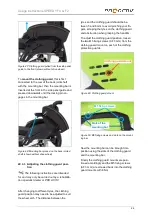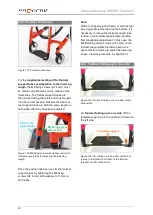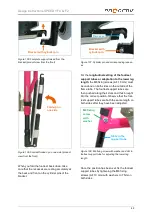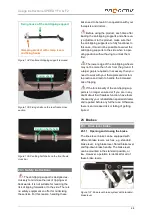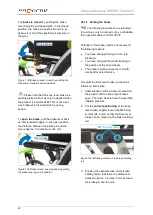
Usage instructions SPEEDY F4 & F2
34
22.2 Caster wheels flapping
Uncontrolled swivelling backwards and for-
wards of the caster wheels around their axes
on the caster fork (while moving) is known as
"fluttering".
If the caster wheels start to flutter, imme-
diately reduce your speed to prevent the caster
wheels from jamming sideways and therefore
reduce your risk of falling.
The
speed limit
where caster wheel fluttering
starts,
is reduced by
:
increasing size of the caster wheels
increase weight of the caster wheels
falling load on the caster wheels
decreasing caster length of caster wheels
The following options are available to
coun-
teract caster fluttering generally
:
When the product is equipped with angle-
adjustable caster-wheel bearing blocks
(and also with welded caster-wheel bear-
ing blocks, depending on the caster fork
equipment), fluttering can be reduced by
reducing the diameter of the caster
wheels
. This means installing a small
caster wheel in a different wheel position in
the caster fork (seat height therefore does
not change) would be one way of reducing
fluttering. However, please note that using
a smaller caster wheel makes it more diffi-
cult to overcome obstacles and makes tip-
ping necessary more often. The smaller
the caster wheel is, the more driving skill is
required.
Another way to reduce the fluttering is the
use of a
lighter caster wheel of the same
diameter
, or, as previously described,
with a smaller diameter
(smaller diameter
only possible where the product has been
fitted with angle-adjustable caster-wheel
bearing blocks).
Figure 89: Caster length
When fitting the product with angle-
adjustable caster-wheel bearing blocks,
the
caster length can be increased
. The
caster length is the distance between the
rotary axle of the caster fork projected onto
the floor and the wheel contact point. The
wheel contact point of the caster wheel
trails behind the rotary axle as it were. The
caster length has a stabilizing effect on
moving in a straight line. Increasing the
caster length can be achieved by mounting
the caster wheel in a different wheel posi-
tion on the caster fork (in doing so, the
front seat height or the angle of the seat
changes; see Chapter 17). Another possi-
bility is to bend the caster wheel axle (see
Chapter 22.4) forwards in the direction of
travel in the lower area. The angle of the
caster wheel axle can be adjusted up to
approximately 4 mm over the length of the
caster wheel bearing block out of the verti-
Caster wheel for rotary axle
Caster length
Wheel contact
point





